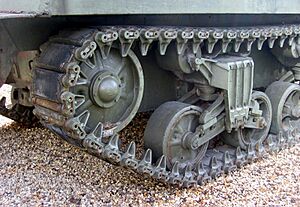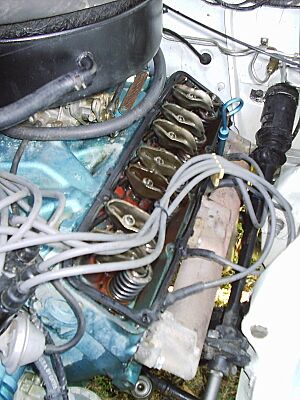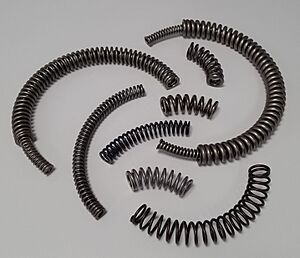Coil spring facts for kids
A coil spring is a bouncy, coiled piece of material. It's used to store energy, absorb bumps, or keep things pressed together. It's made from a stretchy material, shaped like a spiral. When you push or pull it, it bounces back to its original shape.
When you stretch or squeeze a coil spring, the wire itself twists. How well it works depends on how strong and flexible the material is. Sometimes, a coil spring is used to resist twisting. In this case, the spring's material bends, and its strength depends on how easily it can bend.
Contents
How Strong is a Spring?
The "spring rate" tells you how much weight a coil spring can hold before it squeezes down by one inch. For example, if a spring has a rate of 100, it means it will compress one inch when you put 100 pounds of weight on it. Manufacturers usually tell you the spring rate.
Types of Coil Springs
There are a few main types of coil springs, each designed for a different job:
- Tension or Extension Springs: These springs are made to resist being stretched. They usually have hooks or loops at each end so you can attach them to things. Think of the springs on a trampoline!
- Compression Springs: These springs are designed to resist being squeezed. A common place you'll see them is in car suspension systems, helping your car absorb bumps.
- Volute Springs: These are a special kind of compression spring used for very heavy loads. They are made from a flat strip of metal rolled into a spiral shape. This design makes them very strong and allows them to compress a lot without the coils touching each other.
- Arc Springs: These are another special type of coil spring. They were first used in car engines to help transmit power smoothly. They can transfer a twisting force around an axis.
- Torsion Springs: These springs are made to resist twisting actions. You might find them in clothes pegs or the springs that help you open and close garage doors.
Where Are Coil Springs Used?
Coil springs are used in many different places:
- In some computer keyboards, under each key.
- Inside innerspring mattresses to make them bouncy and comfortable.
- In upholstery for furniture, like sofas and chairs.
Coil springs are very common in vehicle suspension. These are compression springs that vary a lot in strength and size. A car's suspension can be stiff or soft, depending on the vehicle. Coil springs can be mounted with a shock absorber or separately.
In trucks, coil springs help them ride smoothly when empty. When the truck is loaded, the springs compress and become stiffer. This helps the truck bounce less. High-performance cars also use coil springs to absorb bumps and reduce body roll when turning. For off-road vehicles, coil springs are great because they allow the wheels to move a lot up and down.
Coil springs are also used in car engines. They are compression springs that help close the valves. These valves control the air going into the engine and the exhaust gases coming out. The spring is connected to a part that opens and closes the valve.
How Coil Springs Are Made
Metal coil springs are made by winding a wire around a shaped tool. For example, a cylinder is used to make cylindrical coil springs.
Coil springs for vehicles are usually made from very strong, hardened steel. A special machine called an "auto-coiler" takes spring wire that has been heated. Heating makes the wire easy to shape. The machine then feeds the wire onto a spinning metal rod that is the size of the desired spring. The machine guides the wire, pushing it across the rod to form many coils.
After the spring is formed, it's removed from the machine and put into oil to cool down quickly. Then, the spring is "tempered." This process helps it lose its brittleness from cooling, making it strong and flexible. The size and strength of the coil spring can be controlled by the size of the rod used and the type of metal alloy. Different metal mixtures are used to give springs special qualities, like stiffness or strength.
See also
- Bogie
- Leaf spring
- Shock absorber
- Spring (device)
- Slinky
- Timmis system





